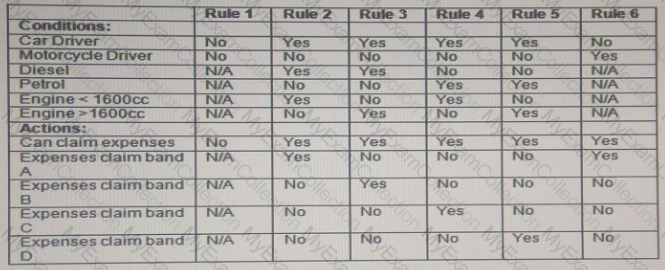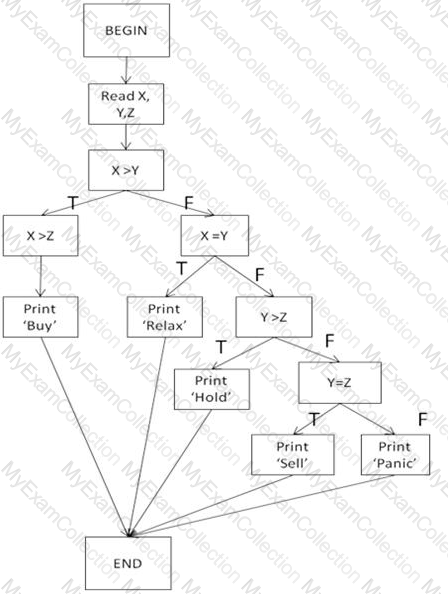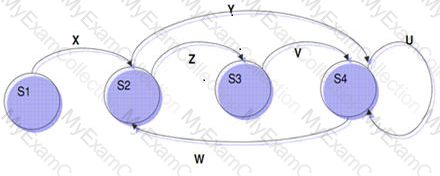A live defect has been found where a code component fails to release memory after it has finished using it.
Which of the following tools would have been the MOST effective at detecting this defect prior to live implementation?

The decision table above reflects a golf club's pricing structure for green fees and buggy/cart hire.
What is the expected result (actions) for each of the following two test cases (TC1 and TC2)?
* TC 1 - Paul is not a full member, is a Loyalty Card holder and requests to play 18 holes with a buggy/cart
* TC 2 - Cheryl is not at full member, doesn't have a Loyalty Card and requests to play 9 holes with a buggy/cart
A new testing tool has been selected for an organisation and a pilot project has successfully completed. The next step is to deploy the tool within the organization.
What is a key success factor in tool deployment?
Your company is developing a system with complex business rules and many branches in the structure of its code components. You need to choose one black box technique and one white box technique for test case design.
Which one of the following offers the BEST choice?
Which of the following represents good testing practice for testers, irrespective of the software lifecycle model used?
A garden irrigation system allows the user to specify 2 inputs:
1. Frequency - The number of times the system should be automatically switched on per day; minimum once per day, maximum 5 times
2. Duration - The duration of operation, in whole minutes, each time it is switched on; ranging from 1 to 60
Applying 2-value boundary value analysis which of the following options has the correct test set of valid and invalid boundary values?
You have been asked to improve the way test automation tools are being used in your company.
Which one of the following is the BEST approach?
A booking system for a city bus service prices its fares according to the time of travel:
• Peak-time tariff starts at 0600 and finishes at 1000 am
• Off-peak tariff applies during all other times of service
• The bus service does not operate between 2300 and the start of the next day’s peak service
Note that all times mentioned are inclusive.
When applying the equivalence partitioning test design technique, which of the following options, shows test case inputs that each fall into a different equivalence partition?
During which stage of the fundamental test process is the testability of requirements evaluated?
Testing effort can depend on a number of factors, which one of following is MOST likely to impact the amount of effort required?
Which of the following type of defect would NOT be typically found by using a static analysis tool?
Which of the following options explain why it is often beneficial to have an independent test function in an organisation?
Your task is to compile a test execution schedule for the current release of software.
The system specification states the following logical dependencies:
• An admin user must create/amend/delete a standard user.
• A standard user is necessary to perform all other actions.
The test plan requires that re-tests must be performed first, followed by the highest priority tests. To save time, the test plan states that tests should be scheduled to create test data for the subsequent tests in the schedule.
The following test cases have been designed, with an indication of priority (1 being the highest priority) and whether the test has previously failed.

Which test execution schedule meets the test plan requirements and logical dependencies?

The decision table above shows a company's fuel expenses structure.
Which of the following Test Cases based on the decision table are Valid?
Test Case 1:
An employee who is not a car or motorcycle driver attempts to claim fuel expenses. Expected result: Expense claim not allowed.
Test Case 2:
An employee who drives a 1700cc diesel car attempts to claim fuel expenses. Expected result: Expense claim accepted at band C.
Test Case 3:
An employee who rides a motorcycle attempts to claim fuel expenses. Expected result: Expense claim accepted at band A.
Which of the following would NOT be a common metric used for monitoring test preparation and execution?
Which of the following would you NOT expect to see on an incident report from test execution?
Which of the following would achieve the HIGHEST level of testing independence for a project's test level?
Which of the following is a defect that is more likely to be found by a static analysis tool than by other testing techniques?
Which of the following optionsBESTexplain the pesticide paradox principle of testing?
Which of the following would be a good test technique to use when under severe time pressure?
You are examining a document which gives the precise steps needed in order to execute a test.
What is the correct definition of this document?
Which of the following has the typical formal review activities in the correct sequence?
Which of the following terms is used to describe the management of software components comprising an integrated system?
What test roles (or parts in the testing process) is a developer most likely to perform?
(i) Executing component integration tests.
(ii) Static analysis.
(iii) Setting up the test environment.
(iv) Deciding how much testing should be automated.
Which of the following are the typical defects found by static analysis tools?
a. Variables that are never used.
b. Security vulnerabilities.
c. Poor performance.
d. Unreachable code.
e. Business processes not followed.
How can test execution tools be of most benefit during exploratory testing?
Which of the following are most characteristic of structure-based testing?
(i) Information about how the software is constructed is used to derive test cases.
(ii) Statement coverage and/or decision coverage can be measured for existing test cases.
(iii) The knowledge and experience of people are used to derive test cases.
(iv) Test cases are derived from a model or specification of the system.
For which of the following activities in the fundamental test process would an incident management tool be most useful?
According to the ISTQB Glossary, regression testing is required for what purpose?
How many test cases are necessary to cover all the possible sequences of statements (paths) for the following program fragment?
Assume that the two conditions are independent of each other : -if (Condition 1)then statement 1else statement 2if (Condition 2)then statement 3
Which of the following statements are TRUE? A. Regression testing and acceptance testing are the same. B. Regression tests show if all defects have been resolved. C. Regression tests are typically well-suited for test automation. D. Regression tests are performed to find out if code changes have introduced or uncovered defects. E. Regression tests should be performed in integration testing.
Which of the following could be a reason for a failure?
1) Testing fault
2) Software fault
3) Design fault
4) Environment Fault
5) Documentation Fault
Which of the following defects is most likely to be found by a test harness?
Which of the following correctly states a limitation in the use of static analysis tools? [K1]
A bank is developing a new service that will be delivered via the web. The user interactions are defined as a set of use cases and the service is designed to be available continuously 24/7. In view of the challenging characteristics of the service the test manager has decided that the code should be thoroughly tested at component level.
Which of the following test types will be required during the development? [K2]
What type of test design technique is the most effective in testing screen-dialog flows?
Which of the following is a valid reason for writing test cases based on experience and intuition? [K1]
Which of the following accurately defines the integration testing test level? [K2]
What content would be in an incident report if that incident report was based on the IEEE 829 Standard for SoftwareTest Documentation?
(i)Identification of configuration items of the software or system.
(ii)Software or system lifecycle process in which the incident was observed.
(iii)Description of the anomaly to enable reproduction of the incident.
(iv)Number of occurrences of the incident.
(v)Classification of the cause of the incident for metrics and for reporting purposes.
Number of correct answers: 1
Which of the following would be appropriate test objectives for user acceptance testing of the first release of a new software product aimed at a general market and built using Agile methods? [K2]
a. To identify as many defects as possible
b. To maximise code coverage
c. To ensure the product works as expected
d. To assess the overall quality of the product
e. To determine the reliability of the product
Of the following, select the best description of the fundamental test process:
Which of the following factors will MOST affect the testing effort required to test a software product? [K1]
Which of the following would typically be identified using static analysis by tools? [K1]
Which of the following test cases will ensure that the statement ‘Print ‘Hold’’ is exercised? [K3]
Refer to the exhibit

Which of the following statements about use-case testing are most accurate?
(i)In a use-case diagram an actor represents a type of user.
(ii)Use-cases are the most common test basis for unit testing.
(iii)A use-case describes interactions between actors.
(iv)An actor is always a human user that interacts with the system.
(v)Test cases can be based on use-case scenarios.
(vi)Use-case testing will often identify gaps not found by testing individual components.
Which of the following would NOT be a typical target of testing support tools?
Refer to the exhibit

Given the following State Transition diagram, match the test cases below with the relevant set of state transitions.
(i)X-Z-V-W
(ii)W-Y-U-U
Under which of the following circumstances is maintenance testing required? [K1]
Which of the following BEST describes the relationship between test planning and test execution? [K2]
Before an invoice can be created, an account is required. Before an account can be set up, an account user is required (in order to set up the account). The software is delivered with a master user only, who can only create other types of users. The following test cases have been written to test the high-level structure of the software
a. Create an invoice
b. Amend an invoice
c. Process an invoice (send to customer)
d. Delete an invoice
e. Create an account
f. Create an account user
g. Amend an account user
h. Delete an account user
i. Amend an account
j. Delete an account
Which of the following test procedures would enable all tests to be run?[K3]

